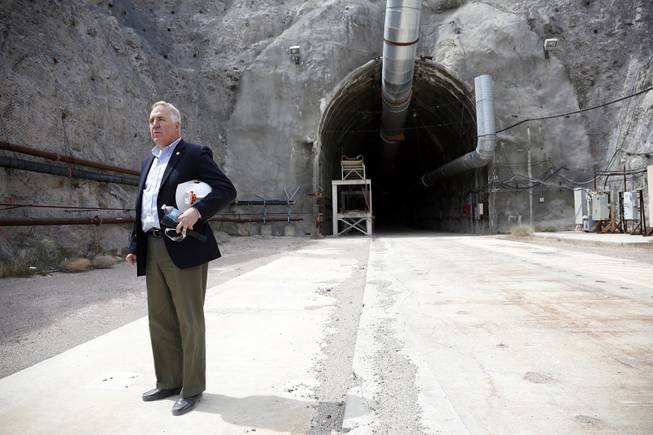
John Locher / AP
Rep. John Shimkus, R-Ill., stands near the north portal of Yucca Mountain during a congressional tour Thursday, April 9, 2015, about 90 miles northwest of Las Vegas.
Tuesday, Feb. 14, 2017 | 2 a.m.
“I’m the nuclear waste guy, that’s what I do in Washington,” said Rep. John Shimkus, R-Ill., after taking a tour last week of the decommissioning process at the San Onofre Nuclear Generating Station near San Diego.
Accompanied by his colleague, Rep. Darrell Issa, R-Calif., Shimkus said he was optimistic that progress could be made on Capitol Hill to deal with stockpiles such as the 3.6 million pounds of spent fuel sitting next to the Pacific Ocean at San Onofre.
But getting it off the beach will take time and, literally, acts of Congress.
“This is a multiple legislative process,” said Shimkus, who is the chairman of the House Energy and Commerce Subcommittee for the Environment, which reviews nuclear sites as part of its responsibilities.
“We gotta get the licensing done, we have to rewrite part of the authorization language,” he said. “We’re optimistic we can move on spending bills.”
With a change of presidential administrations, there have been more rumblings among Capitol Hill Republicans about reviving the Yucca Mountain nuclear waste depository in Nevada.
The federal government has spent about $15 billion at Yucca Mountain to house nuclear waste from sites across the country. However, then-Sen. Harry Reid, D-Nevada, fiercely opposed the site and, after Barack Obama became president in 2009, Reid killed the project.
The site had been slated to open in 2017.
Asked Friday if Yucca Mountain was back on the bargaining table, Shimkus said, “It’s never been off the table.”
San Onofre is far from the only nuclear site where spent fuel has been stranded. More than 76,000 metric tons of used nuclear fuel sit in various facilities across the U.S.
“Don’t feel alone,” said Shimkus. “We’ve got 10 of these all over the country. We’ve got five that are shutting down and we still have nuclear power plants being built. So this has to be a long-term solution.”
If an elusive solution can be worked out, though, Issa wants San Onofre to be at or near the top of the list for shipments heading out.
“We know sitting between Interstate 5 and the water and on this little strip of land is not the right place for these spent rods,” said Issa.
Issa said he’s willing to consider re-opening Yucca “if the science supports it” but in the meantime, he has introduced a new bill aimed at finding “interim consolidated storage” to house spent fuel from sites like San Onofre.
The bill aims to get the U.S. Department of Energy to tap into the massive $35.8 billion Nuclear Waste Fund to help fund the project. The process, even if expedited, would take years.
Officials at one site in West Texas and another in New Mexico have indicated they would be willing to accept spent fuel from nuclear power plants.
“We are making investments for a decade or more from now before you would probably see the elimination of the spent rods,” Issa said. “It’s probably a 10-year process.”
But if the processes are put in place, Shimkus said he had no doubts the spent fuel can be shipped elsewhere.
“I guarantee you it can be moved and can be moved safely,” Shimkus said.
Safety has been a concern raised by some in the area surrounding San Onofre, such as Donna Gilmore, a San Clemente resident, who has questioned the integrity of the stainless steel canisters storing the waste.
“Those canisters could start leaking before you could even get it out of here,” she said in an interview in April 2016.
The operator of San Onofre, Southern California Edison, insists the canisters are safe.
Edison is the majority owner of the facility, and San Diego Gas & Electric owns 20 percent.
An advocacy group, Citizens Oversight, is going to court to try to get the waste at San Onofre transferred to another site, perhaps in Arizona. Its case will be heard later this year.
San Onofre has not produced electricity since January 2012 after a steam generator tube leak. Edison officials overseeing the plant’s decommissioning have set a target date of the end of 2032 to remove nearly every remnant of the generating station.
Shimkus said he’s optimistic progress can be made because he said there “is will and a commitment” by all sides in Washington.
But he said progress figured to be slow.
Asked a second time how long people in the San Onofre area would have to wait, Shimkus said, “Just say a long time — a lot longer than you really hope, I’ll be honest with you.”

Join the Discussion:
Check this out for a full explanation of our conversion to the LiveFyre commenting system and instructions on how to sign up for an account.
Full comments policy